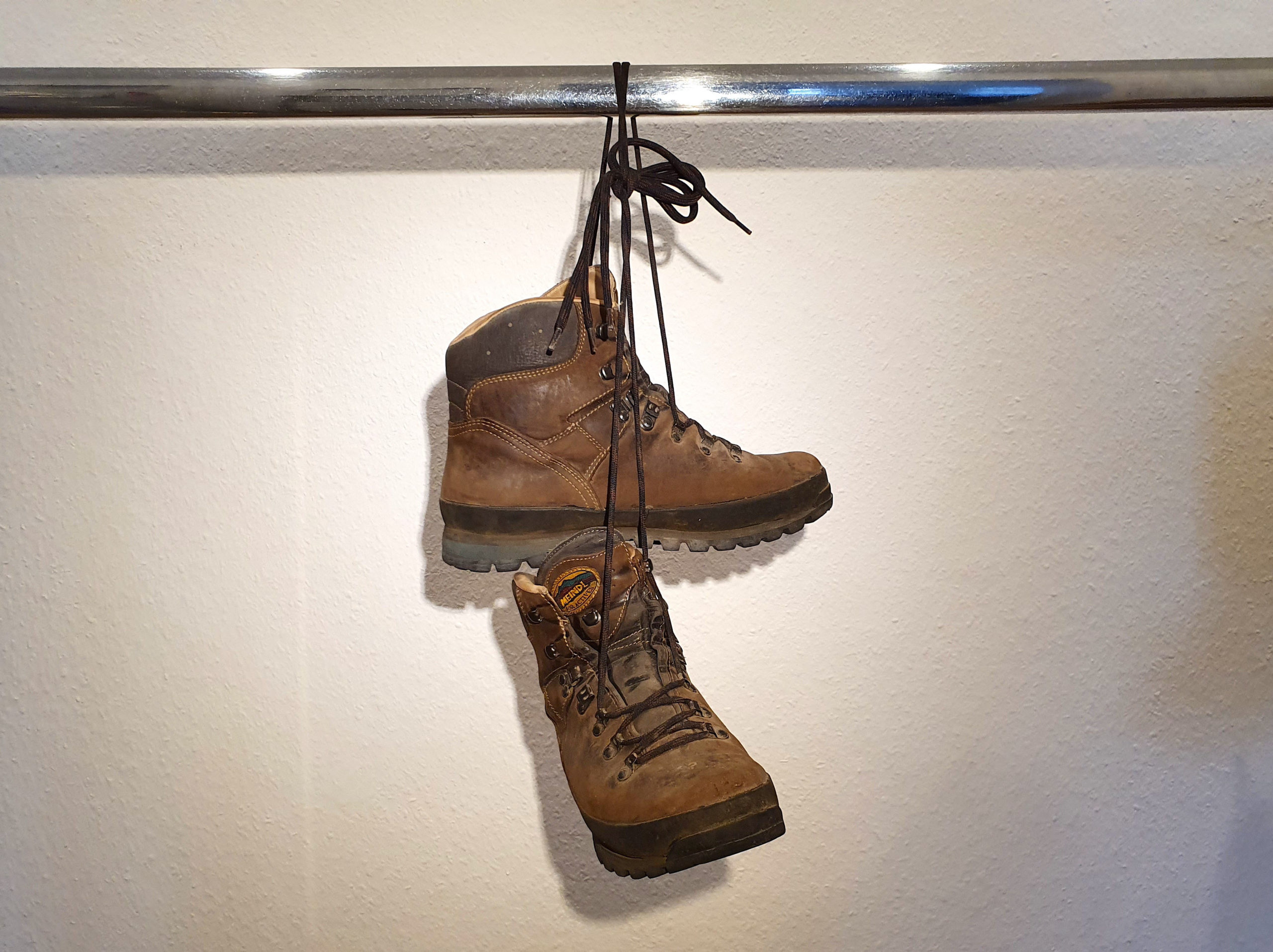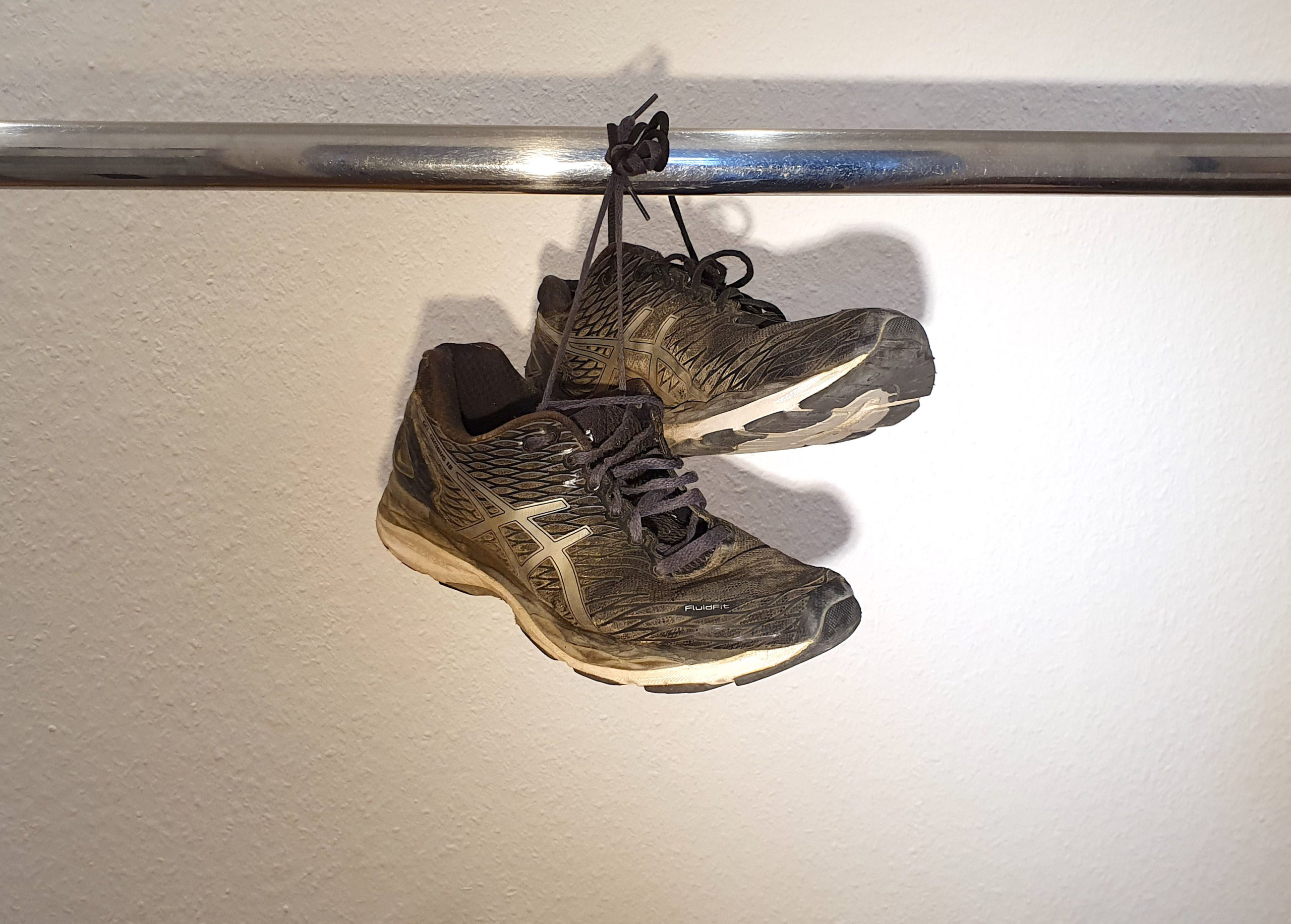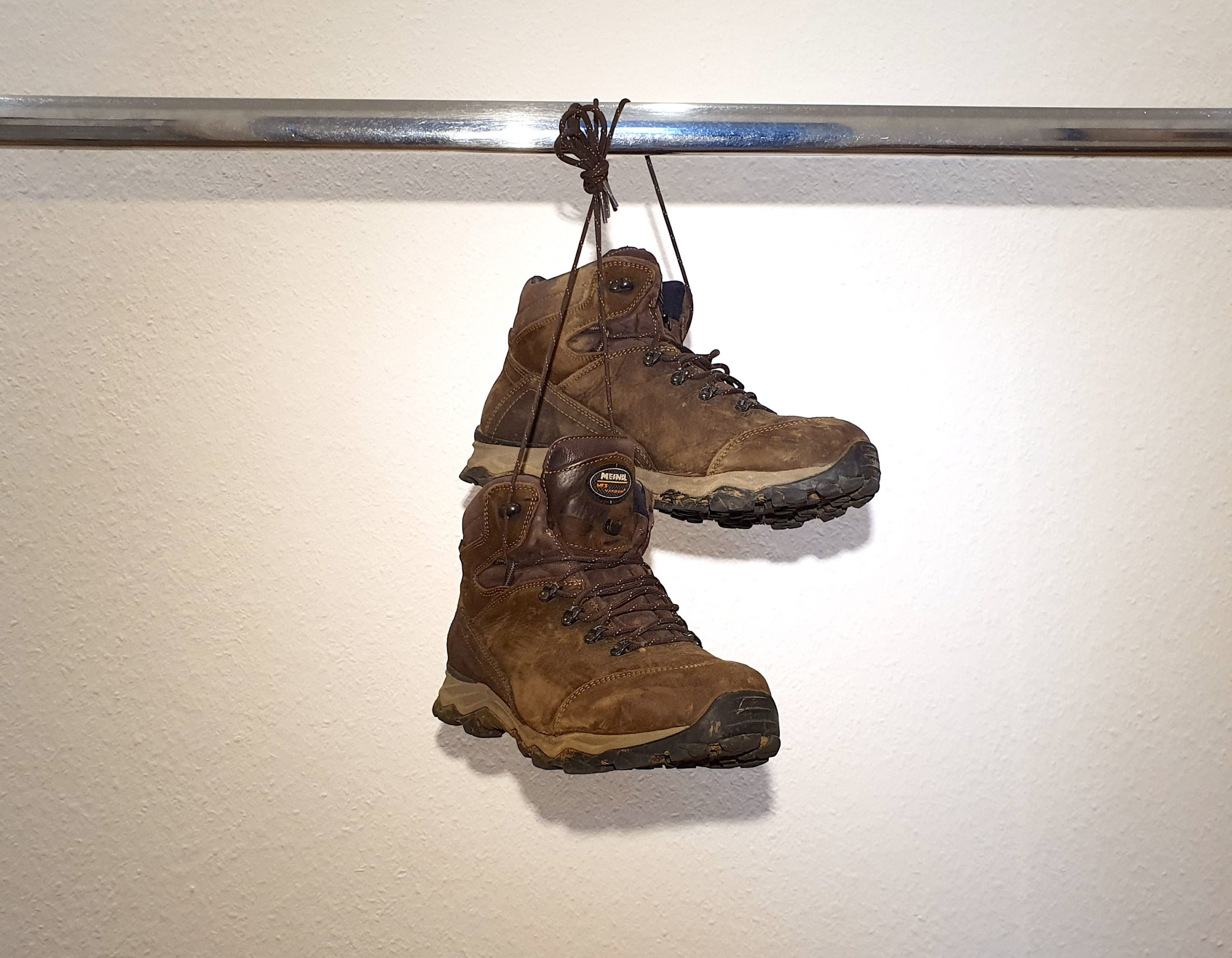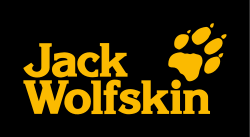
Testimonial: My Hiking Boots
(PLEASE NOTE: MOST OF THE LINKS WILL LEAD YOU TO GERMAN SITES WITHOUT ENGLISH TRANSLATION) The reason why HikingTrailView.com exists is that you can get your own idea of the conditions of a hiking trail. Therefore, you find the excessive documentation in my virtual panoramic tours. With its 360° round view in all directions I want to give you the chance to evaluate the trails clearer for yourself – so you can better prepare yourself for the hike and, foremost, individually choose the kind of hiking shoes you need.
The idea came to me on my first longer hike: the Otter Trail (link to the official nationalpark website), a roughly 40 km long 5 day tour along the coast of the Tritrikamma Nationalpark in South Africa. I had almost no hiking experience at all. And some of my friends were not too happy with the shoes they had chosen. Only a few wore modern hiking boots that perfectly matched the trail conditions. They were experienced hikers who probably would have shared their evaluation if we had asked them. Most of us just plunged into this adventure blue-eyed.
Get an idea of a trail – before the start
The consequences: painful blisters and a dangerous hyperextension of an ankle. The first case was due to brand-new hiking boots. They were almost unused and not thoroughly broken in and did not fit perfectly. Which meant to hobble from day two with pain which could only be eased a bit with a lot of tape or blister pads. In the case of the hyperextended ankle, the last legs of the hike were torturing. The backpack was taken over and carried by others. But the injured friend could not really enjoy the rest of the beautiful hike very much. Of course, accidents happen. However, their occurrence can be minimized during the preparation phase – or evoked by choosing shoes that lack the needed stability for such a long and stony hike: jogging shoes. With this blog post I want to share my personal experiences with very different kind of shoes I used on my hikes.
The shoes that I used on the Otter Trail were light, ankle-high leather boots by Panama Jack. I don't have a photograph of the original pair. (The pair you see blow are similar, yet slightly heavier.) And I do not recall the name. But the model named Gael ankle boots by Panama Jack look very similar.

Up front: they were only of limited use for the trail. They were in every day use for roughly 1,5 years before I went on the hike with them. That's why they were really comfortable. In addition, leather is a good material for a hike in hot summers. But after several hours of hiking the leather of my shoes stretched too much. Although I regularly tightend the laces, the shoes lost their ability to support my feet during the course of a day. Furthermore, the soles were too thin with not enough profile. They neither offered protection from hits from the side nor from sharp stones on the ground which I could feel more and more through the soles the more tired my feet became.
I generally think a great deal of classic leather boots. They are good alternatives to high-tech hiking shoes – but rather for one day hikes. The ones that were too weak for the difficult Otter Trail that takes several strenuous days were perfect for hiking up Lion's Head in Cape Town – which I also hiked up with my second pair of classic leather boots which I will also present further below.
But first I want to talk about my first real hiking shoes: the trekking boots BORNEO 2 MFS by Meindl. I bought them for hiking up Mount Kilimanjaro on the Marangu Route in Tanzania.

It was suitable for almost the entire route. Well, but only almost. I chose leather boots because of the warm region. I did not take into account that the last stage could take place entirely on the icy snow peak of Africa's highest mountain. And the “pole pole” (i.e. walking very slowly) at the extreme altitude, transferred the cold directly into my shoes on the last stage. A year later the tips of my toes still felt slightly numb. However, the BORNEO from Meindl really served me well for the other stages: the higher rubber frame gave me the security to simply march through the many clay puddles, the leather offered the desired breathability, the profile offered perfect grip and the hard sole relieved the stress on my feet even on the uneven and steep sections. The latter was my downfall when I wore these shoes to hike on the Rennsteig . Because of the hard soles, I strained my knees on the very long and fast stages. These also ran over long stretches of tar and gravel. That's why I had to cancel my hike on the Rennsteig after two stages.
Put everything on the list, including your boots
Which brings me to my second pair of real hiking boots. With them I hiked the Rennsteig stages 3 to 6 - although their purchase had two completely different reasons: firstly, the Tour du Mont Blanc and, secondly, that you really shouldn't leave anything out of your preparation list. Even the things that don't really need a list, namely the hiking boots. It wasn't until halfway of my drive to the starting point in Chamonix that I realized that I had forgotten the most important thing for my hike. In Switzerland all the shops were already closed. But later on I was able to find an outfitter in France. I knew it would be tricky walking around Mont Blanc for 12 days in shoes I had never worn before. But I brought a lot of tape to cover my feet anyway. Somehow the new shoes made the Mont Blanc tour even more exciting.
Unfortunately, the saleswoman had no real interest in consulting me. Which meant that the hiking boots fit well. But I should have chosen a size larger–more than the recommended half size bigger than the shoe size I usually wear. And–I only realized this many years later while preparing this article–these shoes are actually a pair for women. However, that might not be such a bad thing if your feet are wider in the front and your heels are comparatively narrow. The pair I talk about are the trekking boots Vortex GTX by TECNICAwhich aren't produced anymore.

It is a solid pair of hiking boots, breathable as well as with a sole which is light and a bit softer. It is appropriate for long and even routes – but also strong enough for rougher terrains. However, the Tour du Mont Blanc musters up everything to show a boot's limits. The side protection offered was not enough. One long and steep descent on sharp shale debris became quite painful in these boots.
In general, the shoes offer little protection against lateral rock impacts because the sides are not additionally reinforced. And a tired foot is simply very sensitive. Nevertheless, the boots got me from Chamonix back to Chamonix safely. I also got used to covering almost my entire foot, including the toes, with Leukoplast tape in the morning to prevent blisters. If it doesn't get too extreme, the shoe is a good all-rounder. Finally, I completed the last four stages of the hike, which I mentioned above, and which I walked just a month after the Tour du Mont Blanc: the Rennsteig. A year later the GR221 followed on Mallorca. From time to time with less tape on the foot, but never completely without it.
The good old leather boot
I told myself that I am one of those hikers that always needs tape on his feet. But this is surely not a must when you look at the shoes you wear every day. And on many hikes, my everyday leather boots did a great job: for example, on one leg of the GR221 in Mallorca which I had to redo for the panoramic photos, on the Lion’s Head as well as several hikes up Table Mountain in Cape Town as well as the ascent of the Pico Turquino in Cuba. Today you only see classic leather boots worn seldomly on hiking trails. In my case it was a pair of Earthkeepers 6-Inch-Boot by Timberland.

The leather is sturdy, the soles are soft but firm, and the boots and their lacing cover your ankles well. Thereby, they offer stability and safety also in rougher terrain and are perfect for one-day-hikes. For multi-day hikes I recommend more modern hiking boots because their material stretches less and offers better foothold as well as greater support for your feet – and it dries faster than leather.
Only one other kind of shoes probably offers more breathability than leather shoes and dries faster than hiking boots: running shoes. Although I never recommend them for hiking I did hikes wearing running shoes. To be more precise, it was a pair of Asics Gel Nimbus 18.

And I really pushed my luck. For one of my hikes in Cuba's Viñales Valley I used my running shoes assuming that the hike would be more of a sunday afternoon walk. But it was far from that. A long and steep ascent on stairs is mostly followed by a steep and slippery descent. Even if it did not rain for two days, it did rain two days ago. With that in mind you should not expect a fully dried path especially in the Caribbean. Rather expect a fully soaked trail. I clearly discourage you from using running shoes for hiking. The remains of the clay puddles in the cracks of my shoes still give testimony. Safety has highest priority on hiking trails. And you are not only responsible for yourself. If something happens to you, you normally draw others in, too. The right shoes are the basis for a safe hiking trip.
Light at the end of the ordeal
Which finally brings me to my last pair of hiking boots. As I already mentioned above, I thought hiking and blisters are a natural combination in my case. But I never got rid of this feeling that a blister-free path was possible for me. Three things were vital to reach this goal: I was ready to pay a bit more money, I was not fussed about how the shoes looked, and I took a lot of time finding the right pair. Even the slightest idea that a shoe could maybe one day in the future pinch my feet while I tried it on, made me abstain from buying it. According to my experience, such a feeling will always result in blisters – roughly two hours into a hike at the latest. I went from shop to shop, tried shoe after shoe, sometimes even the same model in the same size but in another city. (Of course, not on purpose but because an outdoor store lay on my way.) Believe it or not, every shoe feels different. And if I liked a model, I always tested it half a size and a size bigger as well as half a size smaller. Sounds like a terrible customer. But nowadays you can simply order the different sizes to a store and try them on there. Of course, I reserved my favorite pair. And I did not try to buy it somewhere else online where I could maybe save a few Euros. As I said, every shoe feels different. And I kind of wore in my favorite pair already in the shop. I used the little artificial in-store testing trail a lot. The sixth and seventh time were kind of embarrassing. But who cares. I had to do it. And finally I found my first pair of hiking boots that made me reach my goal without any Blister and with perfect foothold: the Meindl Eppan GTX.

I must admit that I have not done multi-day tours in them yet. But at least they easily got me up and down Kanisfluh in Austria's Bregenz Forest with neither tape nor blisters on my feet. The boot is extra wide, but offers a tight fit thanks to a well-placed lacing. The Gore-Tex lining creates a bit too much heat while waking in summer, but there was less moist than expected and the material dried very fast.
Up until now it is a perfect all-rounder. Of course, I still have to walk a more challenging trekking tour that takes several days to get a final opinion. I am excited to go for it – even more happily now that I have shoes I really trust. When the time has come I will write about it here. Feel free to register for my Newsletter now and stay up to date!
Conclusion, tips, and tape on your finger
Yes, your perfect hiking boots do exist. Those that fit your feet perfectly as well as to the hiking trails you walk. You just have to find them. Yet, if the legs of a tour differ extremely – like the last ascent on Mount Kilimanjaro compared to the first days – it could be wise to have more than one pair of shoes with you. Here are my general recommendations:
If it will be cold (icy summits, snow hikes): rather choose Gore-Tex.
If it will be hot (summer tours, closer to the equator): rather choose leather.
Lang and fast on firm ground (e.g. the Rennsteig): soft soles.
Steep uphill (e.g. mountaineering): firmer soles.
One-day-trips: leather boots that are worn in already in your daily life.
Running shoes: no.
I recommend to never use shoes that do not support your ankles. A small stone, a little moment of inattention, and a twisted ankle turns the hiking trip you long waited for into a distressful experience for yourself and for others. The further away you are from villages and streets the more distressful it will be – respectively expensive. Yes, you can call for help with your mobile phone almost everywhere. With an emphasis on not 100% everywhere. And a mountain rescue is not half bad. (A membership in an alpine association (link to the German Alpine Association) could be worthwhile not only because of cheaper rates in one of the association's mountain huts.) In addition, you wear out your fancy running shoes much faster in rough terrain.
From now on I prefer my new all-round trekking boots. Except if I chose very steep and high alpine mountains again one day. Then I would probably have to do another search again. Those who know how annoying blisters are, should try everything to avoid them. Even on your fingers. This is my last tip for shopping shoes: tape those parts of your fingers where you regularly tighten your laces. I tried so many shoes in one day that ... well, it's easy to be wiser after the event. This time even before. Good luck shopping your new hiking boots and enjoy your hikes – both without blisters!

